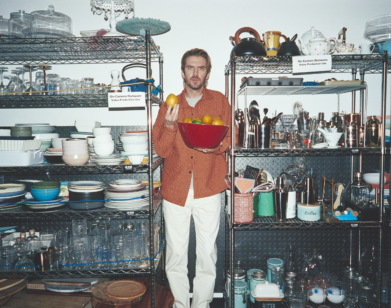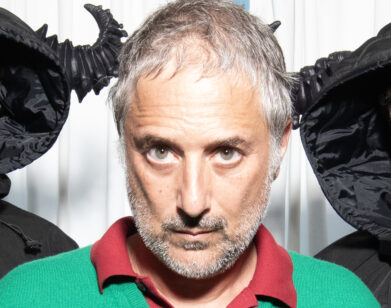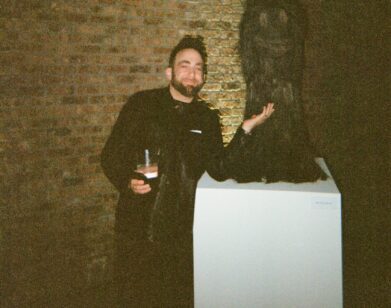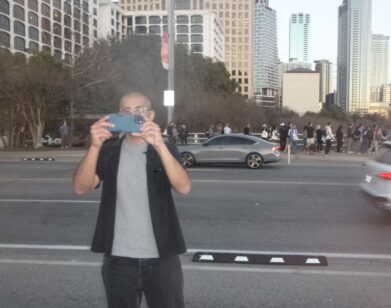The Northwest, The Rules of Suspense, and Imaginary Friends: Gus Van Sant on Restless

GUS VAN SANT. PHOTO BY JACK SIEGEL
Even opponents of auteur theory have to admit that the beautiful Restless—starring Mia Wasikowska as a terminally-ill cancer patient and Henry Hopper as the eccentric, troubled boy who falls in love with her—is more than a film made by Gus Van Sant: it’s fundamentally “a Gus Van Sant film.” It’s dreamy and sweet, for one thing, with a late-autumn color scheme brought to bear by Van Sant’s native Portland. And its themes—youth, death, and the intersection of the two—will be instantly familiar to fans of Paranoid Park, Gerry, and Last Days.
But what really makes it clear that Restless is a Van Sant film is its gentle, tender approach to its characters, Annabel and Enoch, who in the hands of a less capable director might be affected or twee. (Annabel reads Darwin for fun; Enoch is a funeral-crasher whose best friend is Hiroshi, the ghost of a WWII kamikaze pilot. It’s delicate material.) Instead, Annabel and Enoch’s story is timeless and touching; it sneaks up on you, and haunts you for days after the final frame.
ALEXANDRIA SYMONDS: I think that a problem that a lot of directors run into adapting plays is that they up just looking like filmed stage plays, and this isn’t that way at all; it’s such an expansive film. Could you speak a bit to the process of adapting the play and how closely it resembles the original piece?
GUS VAN SANT: [Jason Lew, the writer] wrote a small children’s book kind of thing that was meant to cheer Bryce [Dallas Howard, the producer] up when she was sick once, and they gave me a copy of that. It was an illustrated story—it was really about Hiroshi, there was an Enoch and Annabel in the story but they weren’t the lead characters. Somewhere along the line they decided to write a screenplay, so I don’t really know… [Bryce and Jason] made many, many versions of the screenplay because they would have group readings with friends and they would make comments and changes, and so there were a number of versions of the script.
SYMONDS: At what stage did you become involved?
VAN SANT: At the very end, after it was complete—well, they were in the habit of continually working on it and when they sent it to me I just said, “This is great,” and I didn’t really want them to continue, because I thought it was great the way it was. I think that they just used that moment as their end; I think that they would have continued to work on it… but I kind of liked the idea of sticking with what we had.
SYMONDS: I think that’s a constant artistic impulse, to keep playing with it.
VAN SANT: To keep working. Yeah.
SYMONDS: “A poem is never finished, only abandoned.”
VAN SANT: Yeah. I was into abandoning it.
SYMONDS: All of your films that are set in the Pacific Northwest get at something different about what it’s like to be young in Portland or around that area. Was there anything specific with Restless that you were trying to say about that part of the world, why it’s special, and why it’s different to grow up there than anywhere else?
VAN SANT: In Portland? Well this was originally set in Orono, Maine; it was a little bit of a generic setting, so it wasn’t necessarily me thinking about Portland, it was me thinking about these two kids who could’ve been anywhere. And I kept Orono, Maine in my head, even though we were using Portland, and we just let the signage be Portland. We didn’t really feature Portland; we didn’t have a title on it that said “Portland,” which sometimes I do in my films. I guess there is more and more legendary information about Portland, with Portlandia. [laughs]
SYMONDS: Do you watch Portlandia?
VAN SANT: Yeah, I’ve seen it. I was in it at one point. I know Carrie Brownstein, and now I know Fred a little bit, and it’s really funny. I really think it’s great, but it’s yet one more thing that puts Portland on the map—maybe the biggest thing, because it’s called Portlandia—and Portland has this growing hipster-destination quality. It’s good that it has a comedy about it, because it has been funny over the years. I think it always had that appeal—Reed College was a really interesting and very intelligent school, so that was an attraction, the smallness was an attraction, at one point Nike became an attraction, the bands of the Northwest started becoming an attraction, our filmmakers started becoming a thing that people knew about, and slowly, by the end of the nineties, it was a place to go.
SYMONDS: It’s interesting that you brought up the American idea of Portland among people who don’t live there; one thing I wanted to ask about was the timelessness of Enoch and Annabel and their story. If you put those characters in those costumes in any other movie, they would come off really hipster-y, but it’s just so genuine with them. Is that something that you were thinking about trying to avoid, or did it just come naturally?
VAN SANT: The outfits?
SYMONDS: The costuming, and the fact that they are both pretty eccentric characters; and there have been a lot of eccentric characters in film over the past fifteen or twenty years, who are sort of like that, but in a way that is not as endearing.
VAN SANT: Like mumblecore characters?
SYMONDS: Yeah.
VAN SANT: Jason, as a writer from Maine, he’s pretty much a hipster himself.
SYMONDS: [laughs]
VAN SANT: He was living in New York. I think that he was his own original version of a young writer; he didn’t fit into the Williamsburg version, because the Williamsburg kids look just like the Portland kids. There’s a certain strain of hipster that is quite identifiable and vintage clothing doesn’t seem to be part of the style, except perhaps more recent vintage clothing—’80s and ’70s vintage clothing. But the vintage clothing that these guys are wearing, and the outsiderness quality, really puts them more into a high school setting: they haven’t chosen to live where they live, they’ve been raised there by parents who have chosen to live there, so they’re not really in control of their existence in the city that they’re in. I had them resembling characters that I would see in any small or medium-sized town in the country, that sort of have their own world that they live in, because they are maybe tired of where they live, they’re ready to strike out on their own, but they still have a few more years to go—so they’re enduring those years before they can get out of town. I always thought of them as those types of characters.
SYMONDS: I’m also interested in the use of light in the film. Obviously, you and Harris Savides have a long and successful history of collaboration—can you talk about the two or three most important things you discussed when you sat down to talk about how you wanted the movie to look?
VAN SANT: I think we wanted to know what kind of format we were going to shoot, that’s sort of where we start. I liked the movie Being There, and I had read that they used two lenses, one was a 75 and one was a 35. I think that it was Caleb Deschanel that shot that, Hal Ashby was the director, and it had a kind of elegance to it, and I sometimes felt that it was the choice of lenses, and the art direction was a certain way too. Harris and I are fans of trying to use just one lens sometimes, a 35 or 40-mm lens, we started to gravitate towards this one lens. Previously I had used many different lenses, I had always mixed lens together and then I started to become more and more “one lens” and in this case, “two lenses.” So we chose two lenses and Harris sent away all the other lenses, he shipped them away so that we couldn’t cheat.
SYMONDS: Be tempted?
VAN SANT: Be tempted. So that was a thing that gave it a particular look, because we largely just used the 35 and then sometimes we added the 75. Anne Ross was the art director, she was able to have amazing colors. Even though I now say, “Don’t make a color palette,” and she might not have, but we tended to see these dark maroons and reds and golds. But the colors were really beautiful-looking, one of my favorite things about the film. That was in her hands and I didn’t really have that much to do with it, she showed me things and was really great about keeping me up to speed, but I wasn’t mandating ideas. We had photographs, probably, of things; and Harris likes Ozu.
SYMONDS: Don’t we all.
VAN SANT: We all do. I think that Anne might have thought about that and processed it, because it has certain qualities like that.
SYMONDS: There’s no real mystery in this film—we know what’s going to happen from the beginning. As a storyteller, is it more difficult to accomplish your goal when you don’t have suspense on your side?
VAN SANT: The rules of suspense are that you do know, and you just don’t know when. In the Hitchcock rules of suspense, you are supposed to know that there is a bomb on the bus that might blow up, and then it becomes very tense—but if you don’t know that there’s a bomb and it just blows up, then it’s just a surprise. I think that knowing is part of the suspense-generating side of the story. Jason claims that he was doing it in the sense of—I guess he saw Brecht do it—that someone would come out and say, “This is the story and this is what’s going to happen,” and then you watch it play out… I do think that there’s a suspense element to doing that, when you have the chorus describe what is happening and then you see it play out.
SYMONDS: How did you approach Henry [Hopper] and Mia [Wasikowska] differently than you’ve approached some of the non-professional, younger actors that you’ve worked with previously?
VAN SANT: I think that I do deal with them the same way. When it comes to Mia and Henry, they are so experienced and advanced that I can watch them work, and I can say, “Keep up the good work,” but it kind of goes beyond my ability to push them into different areas because I don’t have the tools, in a theatrical sense, to push them into those areas. They’re already there; they’re already at the place that I want them to be.
I do do the thing where I make them relaxed on the set so it becomes easy to do; that’s a style that I use. I was describing this to a class the other day: I’m pretending like it’s all relaxed and that we have a lot of time, but we always have a schedule, we’re always on a clock, but I don’t let that show, I pretend that there isn’t a clock. And in that way, since they’re not afraid of making a mistake, they usually don’t make a mistake. If there’s this tension and you’ve got to get it done, it makes people make mistakes. The easiest way to work is if things are really calm, so you pretend things are calm, even though they never are. As a director you have all of these pressures that you often see directors dealing with, and it can be annoying so that the director is preoccupied. I think that for the actors, the last thing that they want is a director that’s not watching, a director that goes “Okay, it sounded good to me,” and they were doing something else or preoccupied with something else because they were worried about the light changing. That’s one thing that I’m doing, whether it’s professional actors or novice actors, I’m paying attention to them. I really am paying attention to them—and sometimes I’m pretending that I’m paying attention to them. [laughs] But I think in general I’m really interested in what they’re doing. That works with both non-actors and actors.
SYMONDS: The Hiroshi character is sort of this fantastical element in a film that’s otherwise mired in very real, difficult emotional content; but the tone stays consistent, even in his scenes. How did you handle that?
VAN SANT: Yeah, Enoch calls him a ghost, but I think I suspect myself that he’s an imaginary friend, so I think that was my way of figuring out who Hiroshi was and how you dealt with him. I just dealt with him like he was real. We did a couple of tests where you could see through him, where he was like a ghost, and that just didn’t seem to work. That was my style of dealing with this character that was not real. In the play Harvey, there’s a big rabbit, I don’t remember if you can see him or not—it’s kind of like the Harvey role, where he is just there and Jimmy Stewart is referring to him, but it’s all in Jimmy Stewart’s mind.
RESTLESS IS OUT IN THEATERS TODAY.






